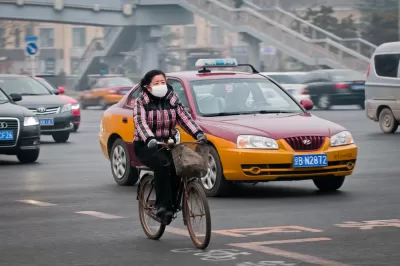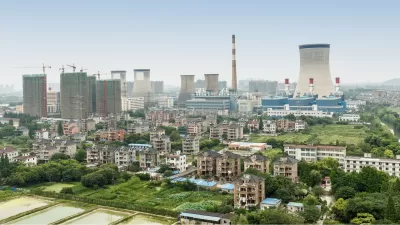Beijing has strayed so far from its roots as a bicycling city that it now claims the title of the world's largest auto market, while only 12 per cent of commuters use bicycles. City planners wants to make it popular again to reduce air pollution.

"Bikes became an integral part of China’s culture after the Communist revolution in 1949," writes Owen Guo, news researcher for The New York Times in Beijing. "Along with a sewing machine and a watch, a bicycle was once considered one of the three must-haves of every Chinese household."
As China has urbanized, families have become more prosperous and many city residents have moved to suburbs many miles from their jobs. The resulting growth in car use combined with lax law enforcement has undermined a half-century tradition of commuting on bikes.
How far and fast China's capital city has strayed from those roots. Consider that in 2000, 38 percent of commuters cycled to work. Guo writes a comprehensive piece that looks at the challenges that planners face to increase cycling.
Beijing "wants to increase the proportion of commuters who use bikes to 18 percent by 2020, according to city transportation officials," writes Guo. But the challenges are formidable.
A study (published in August) by researchers at Peking University in Beijing found that air pollution, safety concerns and a lack of road space were the main reasons people avoided biking to work in the capital.
"The negative perception that bicycle lanes have gradually been taken over by motorized vehicles is one key reason that deters motorized commuters from bicycling," write researchers Ming Yang and John Zacharias, which is confirmed anecdotally by Guo.
One reason for motorists parking in bike lanes is that "(t)he city has designed parking capacities that can accommodate only half of its five million cars, said Li Wei, an engineer at the Beijing Municipal Institute of City Planning and Design.
Outside of the capital city's horrific air pollution, cycling conditions share similarities with the United States. "(T)he city’s transportation policies have long favored cars," stated Wei, which any American cyclist can identify with.
Hat tip: Jennifer Scholtes, Politico Morning Transportation
FULL STORY: A City Choking on Cars Hopes Commuters Will Return to Two Wheels

Planetizen Federal Action Tracker
A weekly monitor of how Trump’s orders and actions are impacting planners and planning in America.

San Francisco's School District Spent $105M To Build Affordable Housing for Teachers — And That's Just the Beginning
SFUSD joins a growing list of school districts using their land holdings to address housing affordability challenges faced by their own employees.

The Tiny, Adorable $7,000 Car Turning Japan Onto EVs
The single seat Mibot charges from a regular plug as quickly as an iPad, and is about half the price of an average EV.

Seattle's Plan for Adopting Driverless Cars
Equity, safety, accessibility and affordability are front of mind as the city prepares for robotaxis and other autonomous vehicles.

As Trump Phases Out FEMA, Is It Time to Flee the Floodplains?
With less federal funding available for disaster relief efforts, the need to relocate at-risk communities is more urgent than ever.

With Protected Lanes, 460% More People Commute by Bike
For those needing more ammo, more data proving what we already knew is here.
Urban Design for Planners 1: Software Tools
This six-course series explores essential urban design concepts using open source software and equips planners with the tools they need to participate fully in the urban design process.
Planning for Universal Design
Learn the tools for implementing Universal Design in planning regulations.
Smith Gee Studio
City of Charlotte
City of Camden Redevelopment Agency
City of Astoria
Transportation Research & Education Center (TREC) at Portland State University
US High Speed Rail Association
City of Camden Redevelopment Agency
Municipality of Princeton (NJ)




























